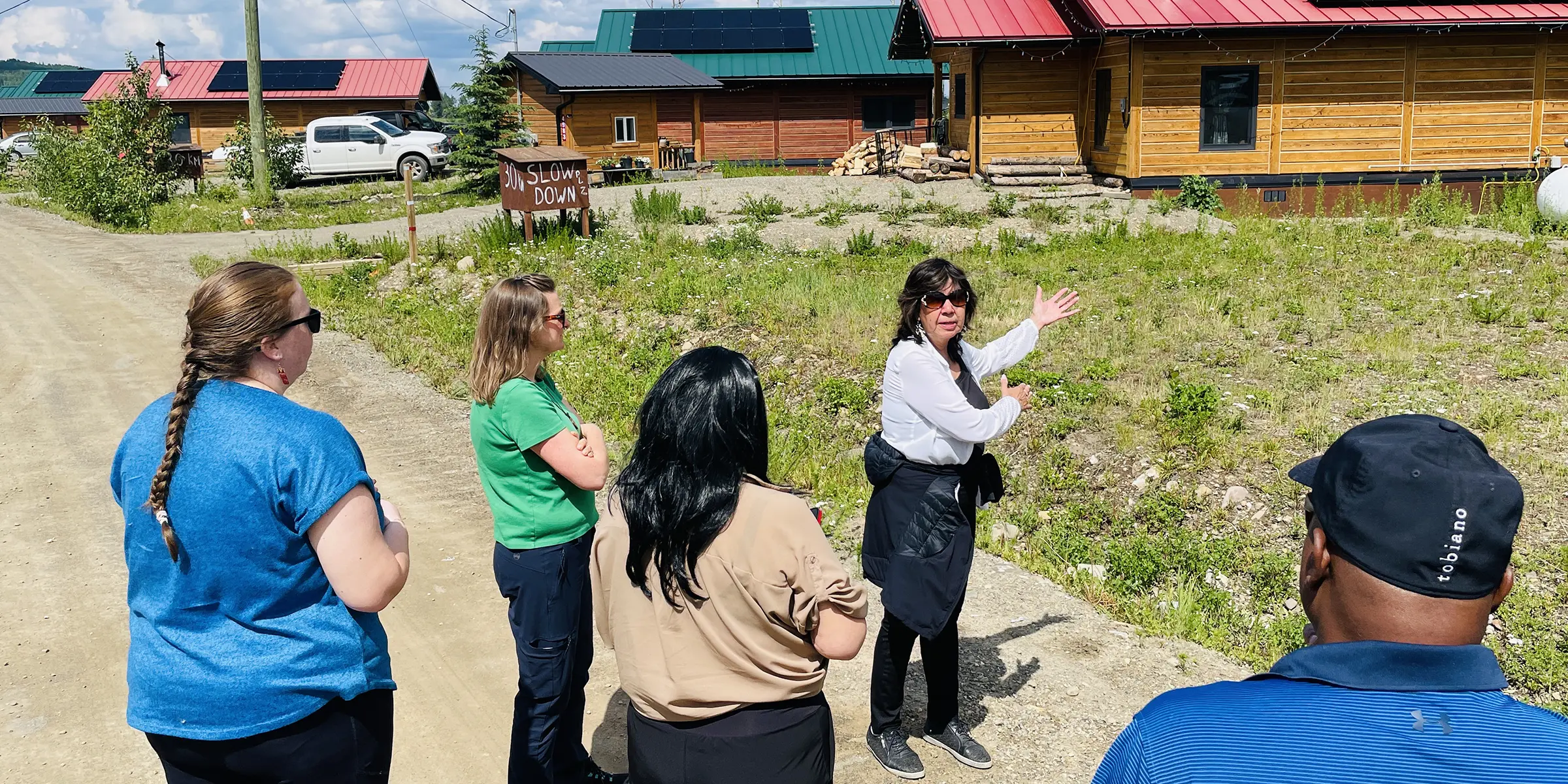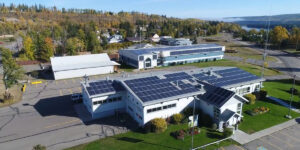
Saulteau First Nations’ Community-Wide Residential Solar Program
Case Study
Published: May 28, 2025
Updated: n/a
Relevant Topics: Policy, Transportation
The Saulteau First Nations is installing solar panels on nearly all of the homes in their community, bringing benefits ranging from cost-savings to community capacity and skill development, all in a region with cold and dark winters.
Feature photo: Saulteau First Nations housing manager, Cindy O’Brien, describes the solar installations on elders’ homes that kick-started a program to install solar panels on most of the homes in the community.
Published: Sep. 4, 2025
Updated: n/a
Relevant Topics: Solar
Climate Zone: 7a
Context
Saulteau First Nations has a population of approximately 450 people living in a community on the shore of Moberly Lake in northeastern BC, roughly 100km southwest of Fort St. John. This is a community in Climate Zone 7a that experiences very cold winters and warm summers. In fact, annual temperatures can span 80 degrees and range between -40 and +40 degrees Celsius. It is also in a region that has been experiencing drought in recent years.
This part of northeastern BC is active with large-scale development of both renewable and non-renewable sources of energy including oil and gas, hydro, and wind. Local energy resiliency and self-sufficiency has been a priority for the Saulteau First Nations since 2016, and this has included several initiatives:
- regional wind projects to produce power for the BC Hydro grid
- an ownership stake in the Coastal GasLink LNG pipeline
- two bioenergy systems to produce heat for community facilities
- a community-wide program to add rooftop solar panels on new and existing homes.
The community is on the BC Hydro grid but does not have access to natural gas. Sources of home heating include propane and firewood.

Contributors

Rob van Adrichem
Director of External Relations
Community Energy Association
Local Realities
Why the Saulteau First Nations initiated their solar project
- High home energy costs, exacerbated by housing with inefficient appliances, leaky building envelopes, and poor insulation
- Occasional power outages every year
- Few household-level benefits associated with regional energy infrastructure.

Journey to a Solution
The first effort to produce electricity from solar panels in the community came in 2020 with the construction of ten, new elders’ homes. A dozen solar panels were installed on the south-facing roofs of each of the buildings – installation was by Sunspear Microgrid and involved training for local residents, with funding provided by the New Relationship Trust.
See this Sunspear video for more information and commentary from local residents:
The success of this pilot project, which included electricity cost savings of approximately 60-70%, along with access to provincial and federal funding for Indigenous clean energy projects, prompted the Saulteau First Nations to explore the addition of solar panels to most, if not all, of the existing homes in the community. Most of the early installations involved 10-12 panels producing approximately 5 kilowatts. The solar program is being pursued over multiple years, and has been led by the Capital Projects and Housing departments. A pre- and post-installation Energuide assessment is also completed for each home participating in the solar program.
The fourth phase of the installation began in 2025 and is adding approximately 55 installations in 2025 alone. This will bring the total number of homes in the community with a rooftop solar system to 140, which is roughly 90% of the homes in the community. The cost of a 5kW solar install is averaging $15,000-$20,000 per home.
“If it wasn’t for the various sources of external funding and the commitment from chiefs and council members over the years, we wouldn’t have been able to do this.”
Shane Reynolds,
Manager of Assets and Capital Projects,
Saulteau First Nations
Outcomes
1. Savings
Savings for individual residents depends on the orientation and energy-efficiency of the home, the size of the individual solar array, as well possible shading of the solar panels from trees, but residents are reporting savings of between $900 to $1700 per year.
2. Expansion
The community enthusiasm for the solar project has prompted the Nation to launch related programs:
- Enhancing the energy performance of homes by adding insulation, new windows and doors, and replacing inefficient appliances such as propane hot water tanks.
- Adding home-battery installations connected to the solar panels on individual homes to enhance energy resiliency.
- Updating the exterior materials on homes to be more FireSmart.
3. Catalyst
The solar program was the catalyst for a “energy-efficiency pathway” for the Saulteau First Nations, according to Shane Reynolds, Manager of Assets and Capital Projects for the Saulteau First Nations.
4. Employment
The success of the program, the acquisition of grant funding, and additional investment from the Saulteau First Nations are resulting in additional local employment through the solar project, as well as ongoing management and maintenance of housing in community.
5. Increased capacity
The roll-out of the solar program at a scale involving dozens of homes per year and related improvements in energy-efficiency and resiliency has contributed to community pride but also enhanced the capacity and confidence of the Saulteau First Nations Government to implement a variety of programs aimed at energy, affordability, and comfort aligned with asset management. Increased capacity in the departments managing community infrastructure, for example, means that “We can now just get these projects done,” according to Housing Manager, Cindy O’Brien.
Contributors

Rob van Adrichem
Director of External Relations
Community Energy Association
Funding for this case study provided by:



Related Content
District of Hudson’s Hope benefitting from solar panels on municipal facilities
Hudson’s Hope attracted nearly $1.3 million in grant funding to install solar panels on all of its large municipal facilities in 2018 and now saves approximately $63,000 per year on electricity costs.

